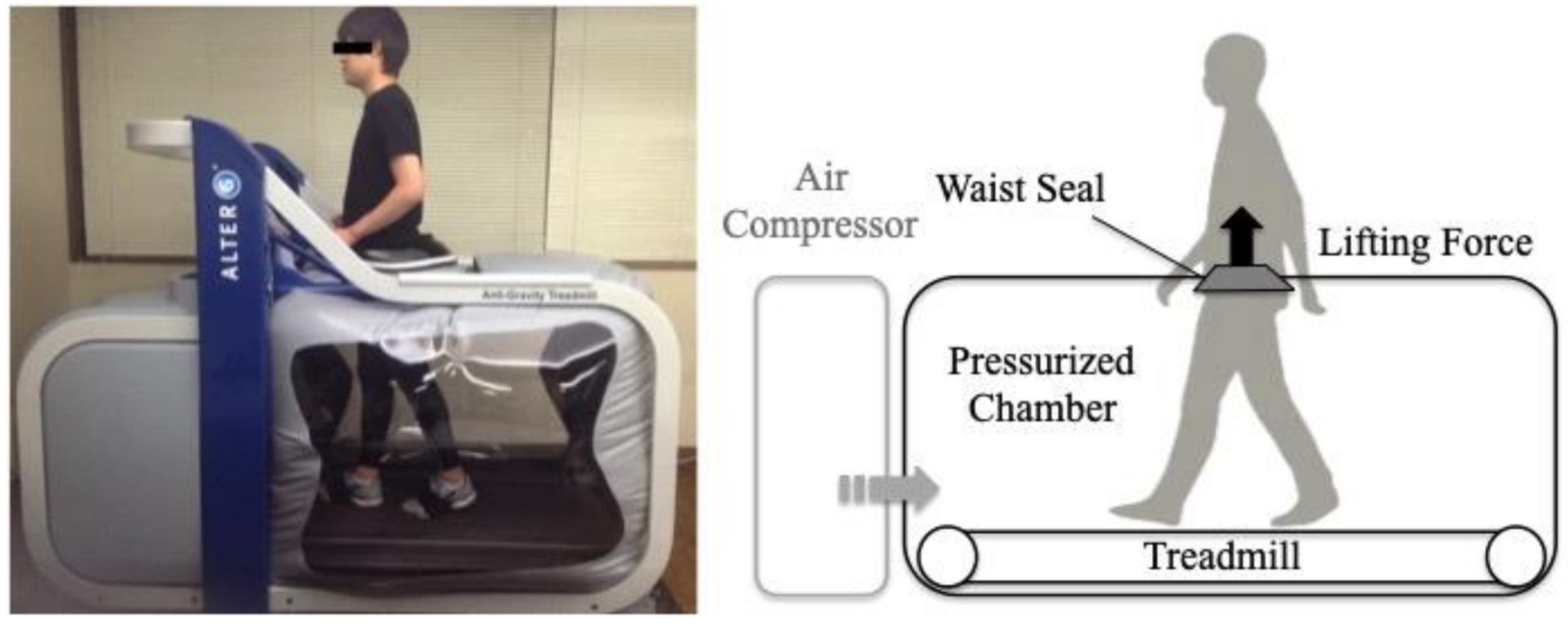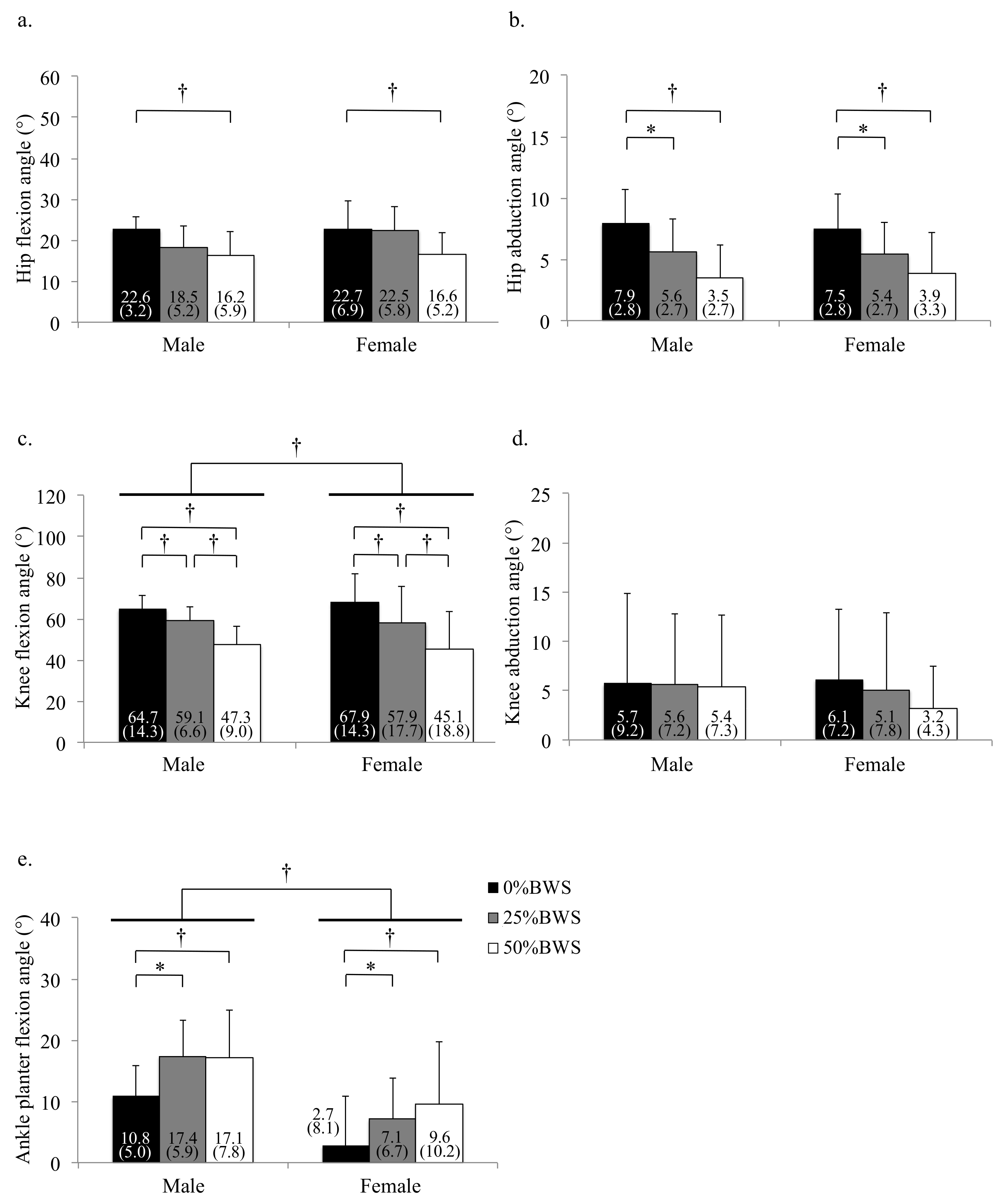Analysis of 3-D Kinematics Using H-Gait System during Walking on a Lower Body Positive Pressure Treadmill
Abstract
1. Introduction
2. Materials and Methods
2.1. Participants
2.2. H-Gait System
2.3. Walking Protocol
2.4. Data Collection
2.5. Statistical Analysis
3. Results
3.1. The Effects of BWS on Spatiotemporal Gait Parameters
3.2. The Effects of BWS on Kinematics during the Stance Phase
3.3. The Effects of BWS on Kinematics during the Swing Phase
3.4. The Effects of Sex on Spatiotemporal Gait Parameters and Kinematics
4. Discussion
5. Conclusions
Author Contributions
Funding
Institutional Review Board Statement
Informed Consent Statement
Data Availability Statement
Conflicts of Interest
References
- Eastlack, R.K.; Hargens, A.R.; Groppo, E.R.; Steinbach, G.C.; White, K.K.; Pedowitz, R.A. Lower body positive-pressure exercise after knee surgery. Clin. Orthop. Relat. Res. 2005, 431, 213–219. [Google Scholar] [CrossRef] [PubMed]
- Quigley, E.J.; Noh, H.; Groppo, E.R.; Cutuk, A.; Pedowitz, Z.; Hargens, A. Gait mechanics using a lower body positive pressure chamber for orthopaedic rehabilitation. Trans. Orthop. Res. Soc. 2000, 25, 828. [Google Scholar]
- Grabowski, A.M. Metabolic and biomechanical effects of velocity and weight support using a lower-body positive pressure device during walking. Arch. Phys. Med. Rehabil. 2010, 91, 951–957. [Google Scholar] [CrossRef] [PubMed]
- Patil, S.; Steklov, N.; Bugbee, W.D.; Goldberg, T.; Colwell, C.W., Jr.; D’Lima, D.D. Anti-gravity treadmills are effective in reducing knee forces. J. Orthop. Res. 2013, 31, 672–679. [Google Scholar] [CrossRef]
- Ruckstuhl, H.; Kho, J.; Weed, M.; Wilkinson, M.W.; Hargens, A.R. Comparing two devices of suspended treadmill walking by varying body unloading and Froude number. Gait Posture 2009, 30, 446–451. [Google Scholar] [CrossRef]
- Takacs, J.; Leiter, J.R.; MacDonald, P.B.; Peeler, J.D. Lower body positive pressure: An emerging technology in the battle against knee osteoarthritis? Clin. Interv. Aging 2003, 8, 983–991. [Google Scholar]
- Peeler, J.; Chrisian, M.; Cooper, J.; Leiter, J.; MacDonald, P. Managing knee Osteoarthritis: The effects of body weight supported physical activity on joint pain, function and thigh muscle strength. Clin. J. Sport Med. 2015, 25, 518–523. [Google Scholar] [CrossRef]
- Kataoka, Y.; Shimizu, T.; Takeda, R.; Tadano, S.; Saito, Y.; Osuka, S.; Ishida, T.; Samukawa, M.; Irie, T.; Takahashi, D.; et al. Effects of unweighting on gait kinematics during walking on a lower-body positive-pressure treadmill in patients with hip osteoarthritis. BMC Musculoskelet. Disord. 2021, 22, 46. [Google Scholar] [CrossRef]
- Cutuk, A.; Groppo, E.R.; Quigley, E.J.; White, K.W.; Pedowitz, R.A.; Hargens, A.R. Ambulation in simulated fractional gravity using lower body positive pressure: Cardiovascular safety and gait analyses. J. Appl. Physiol. 2006, 101, 771–777. [Google Scholar] [CrossRef]
- Cho, S.H.; Park, J.M.; Kwon, O.Y. Sex differences in three dimensional gait analysis data from 98 healthy Korean adults. Clin. Biomech. 2004, 19, 145–152. [Google Scholar] [CrossRef]
- Hurd, W.J.; Chmielewski, T.L.; Axe, M.J.; Davis, I.; Snyder-Mackler, L. Differences in normal and perturbed walking kinematics between male and female athletes. Clin. Biomech. 2004, 19, 465–472. [Google Scholar] [CrossRef]
- Chumanov, E.S.; Wall-Scheffler, C.; Heiderscheit, B.C. Sex differences in walking and running on level and inclined surfaces. Clin. Biomech. 2008, 23, 1260–1268. [Google Scholar] [CrossRef]
- Loverro, K.; Hasselquist, L.; Lewis, C. Females and males use different hip and knee mechanics in response to symmetric military-relevant loads. J. Biomech. 2019, 95, 109280. [Google Scholar] [CrossRef]
- Tadano, S.; Sasaki, K.; Fujisawa, T.; Tohyama, H. Gait characterization for osteoarthritis patients using wearable gait sensors (H-Gait systems). J. Biomech. 2016, 49, 684–690. [Google Scholar] [CrossRef]
- Tadano, S.; Takeda, R.; Miyagawa, H. Three dimensional gait analysis using wearable acceleration and gyro sensors based on quaternion calculations. Sensors 2013, 13, 9321–9343. [Google Scholar] [CrossRef]
- Takeda, R.; Lisco, G.; Fujisawa, T.; Gastaldi, L.; Tohyama, H.; Tadano, S. Drift removal for improving the accuracy of gait parameters using wearable sensor systems. Sensors 2014, 14, 23230–23247. [Google Scholar] [CrossRef]
- Sainton, P.; Nicol, C.; Cabri, J.; Barthelemy-Montfort, J.; Chavet, P. Kinetics and Muscle Activity Patterns during Unweighting and Reloading Transition Phases in Running. PLoS ONE 2016, 11, e0168545. [Google Scholar] [CrossRef][Green Version]
- Aminian, K.; Najafi, B.; Bula, C.; Leyvraz, P.-F.; Robert, P. Spatio-temporal parameters of gait measured by an ambulatory system using miniature gyroscopes. J. Biomech. 2002, 35, 689–699. [Google Scholar] [CrossRef]
- Hesse, S.; Bertelt, C.; Jahnke, M.T.; Schaffrin, A.; Baake, P.; Malezic, M.; Mauritz, K.H. Treadmill training with partial body weight support compared with physiotherapy in non-ambulatory hemiparetic patients. Stroke 1995, 26, 976–981. [Google Scholar] [CrossRef]
- Hesse, S.; Helm, B.; Kranjnik, J.; Gregoric, M.; Mauritz, K.H. Treadmill training with partial body weight support: Influence of body weight release on the gait of hemiparetic patients. J. Neuro Rehabil. 1997, 11, 15–20. [Google Scholar] [CrossRef]
- Lucareli, P.R.; Lima, M.O.; Lima, P.S.; Almeida, J.G.; Brech, G.C.; D’Andréa Greve, J.M. Gait analysis following treadmill training with body weight support versus conventional physical therapy: A prospective randomized controlled single blind study. Spinal Cord. 2011, 49, 1001–1007. [Google Scholar] [CrossRef]
- Kerrigan, D.C.; Todd, M.K.; Croce, U.D. Gender differences in joint biomechanics during walking: Normative study in young adults. Am. J. Phys. Med. Rehabil. 1998, 77, 2–7. [Google Scholar] [CrossRef]








| Variables | 0%BWS | 25%BWS | 50%BWS | Main Effect: BWS (p-Value) | |
|---|---|---|---|---|---|
| Knee adduction (°) | Male Female | 11.8 (3.2) 8.0 (2.9) | 10.6 (3.0) 7.8 (3.4) | 7.3 (3.6) *,† 7.3 (3.6) *,† | 0.001 |
| Ankle dorsiflexion (°) | Male Female | 6.9 (6.1) 12.2 (5.5) | 5.0 (3.1) # 8.4 (4.7) # | 3.1 (4.5) † 4.6 (4.1) † | 0.001 |
| Hip flexion (°) | Male Female | 22.6 (3.2) 22.7 (6.9) | 18.5 (5.2) 22.5 (5.8) | 16.2 (5.9) † 16.6 (5.2) † | 0.004 |
| Knee flexion (°) | Male Female | 64.7 (14.3) 67.9 (14.3) | 59.1 (6.6) † 57.9 (17.7) † | 47.3 (9.0) †,$ 45.1 (18.8) †,$ | <0.001 |
| Ankle plantar flexion (°) | Male Female | 10.8 (5.0) 2.7 (8.1) | 17.4 (5.9) # 7.1 (6.7) # | 17.1 (7.8) † 9.6 (10.2) † | 0.003 |
Publisher’s Note: MDPI stays neutral with regard to jurisdictional claims in published maps and institutional affiliations. |
© 2021 by the authors. Licensee MDPI, Basel, Switzerland. This article is an open access article distributed under the terms and conditions of the Creative Commons Attribution (CC BY) license (https://creativecommons.org/licenses/by/4.0/).
Share and Cite
Kataoka, Y.; Takeda, R.; Tadano, S.; Ishida, T.; Saito, Y.; Osuka, S.; Samukawa, M.; Tohyama, H. Analysis of 3-D Kinematics Using H-Gait System during Walking on a Lower Body Positive Pressure Treadmill. Sensors 2021, 21, 2619. https://doi.org/10.3390/s21082619
Kataoka Y, Takeda R, Tadano S, Ishida T, Saito Y, Osuka S, Samukawa M, Tohyama H. Analysis of 3-D Kinematics Using H-Gait System during Walking on a Lower Body Positive Pressure Treadmill. Sensors. 2021; 21(8):2619. https://doi.org/10.3390/s21082619
Chicago/Turabian StyleKataoka, Yoshiaki, Ryo Takeda, Shigeru Tadano, Tomoya Ishida, Yuki Saito, Satoshi Osuka, Mina Samukawa, and Harukazu Tohyama. 2021. "Analysis of 3-D Kinematics Using H-Gait System during Walking on a Lower Body Positive Pressure Treadmill" Sensors 21, no. 8: 2619. https://doi.org/10.3390/s21082619
APA StyleKataoka, Y., Takeda, R., Tadano, S., Ishida, T., Saito, Y., Osuka, S., Samukawa, M., & Tohyama, H. (2021). Analysis of 3-D Kinematics Using H-Gait System during Walking on a Lower Body Positive Pressure Treadmill. Sensors, 21(8), 2619. https://doi.org/10.3390/s21082619






